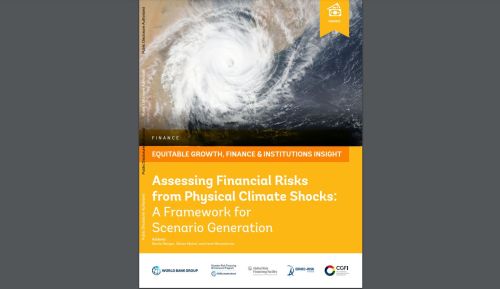
New paper by Irene Monasterolo published with the World Bank
Written on 24 Feb 2022.

Climate change has become a main concern of ministries of finance, central banks, and financial regulators. In response, a suite of scenarios and tools have been developed to assess the financial risks from physical climate shocks (for example, hurricanes, droughts, wildfires, flooding). However, those scenarios do not fully capture such shocks, which could lead financial institutions to underestimate the potential scale of climate risks and underprice investments in resilience. This is particularly important for emerging markets and developing economies where exposure to physical climate risks is already high and is expected to further increase with climate change.
We are very pleased to share with you new World Bank paper by Irene Monasterolo Professor of Finance EDHEC Business School, EDHEC-Risk Institute "Assessing Financial Risks from Physical Climate Shocks: A Framework for Scenario Generation" with Dr Nicola Ranger, Oxford Sustainable Finance Group, Smith School of Enterprise and the Environment, University of Oxford and the UK Centre for Greening Finance and Investment and Olivier Mahul, Practice Manager, Crisis and Disaster Risk Finance Unit, The World Bank, on the role of climate physical risks scenarios for climate financial risk assessment, the limitations of current scenarios and how to address them in a coherent framework.
This paper identifies potential gaps in current scenarios widely available for physical climate financial risk assessment and aims to improve the understanding and design of physical climate financial risk scenarios, including for climate stress testing. Those gaps represent material financial risks that cannot be ignored within physical climate financial risk assessment. Tools and approaches are readily available and tried and tested to capture these risks within physical climate financial risk assessment
In order to address those gaps, the paper identifies five areas, or risk drivers, that make a material contribution to physical climate risks to the financial sector and that are not consistently included in current scenarios and tools:
- extreme weather events
- uncertainties in climate models
- compound scenarios
- indirect economic impacts of shocks
- feedback between the real economy and the financial sector
Author derive a framework for generating scenarios to assess acute physical climate-related financial risks, which is inspired by the “Realistic Disaster Scenarios” that are used in risk management and supervision in the insurance sector. The framework is illustrated through an application of the EIRIN macroeconomic model. This framework aims to complement recent work by the Network of Central Banks and Supervisors for Greening the Financial System (NGFS) and the Financial Stability Board (FSB) to inform ministries of finance, central banks, financial regulators, and financial institutions on climate financial risk assessments, both for micro- and macroprudential risk management, and to incorporate climate risks into wider financial decision making and disclosures.
Such scenarios need not be complex, but instead should aim to represent the material risk drivers and risk transmission channels, the range of plausible outcomes, and their interactions.
TOPICS: physical climate risk, climate-related financial risk scenarios, risk drivers, macrofinancial feedbacks, macroprudential supervision, risk management, low-income countries
© 2022 International Bank for Reconstruction and Development / The World Bank

